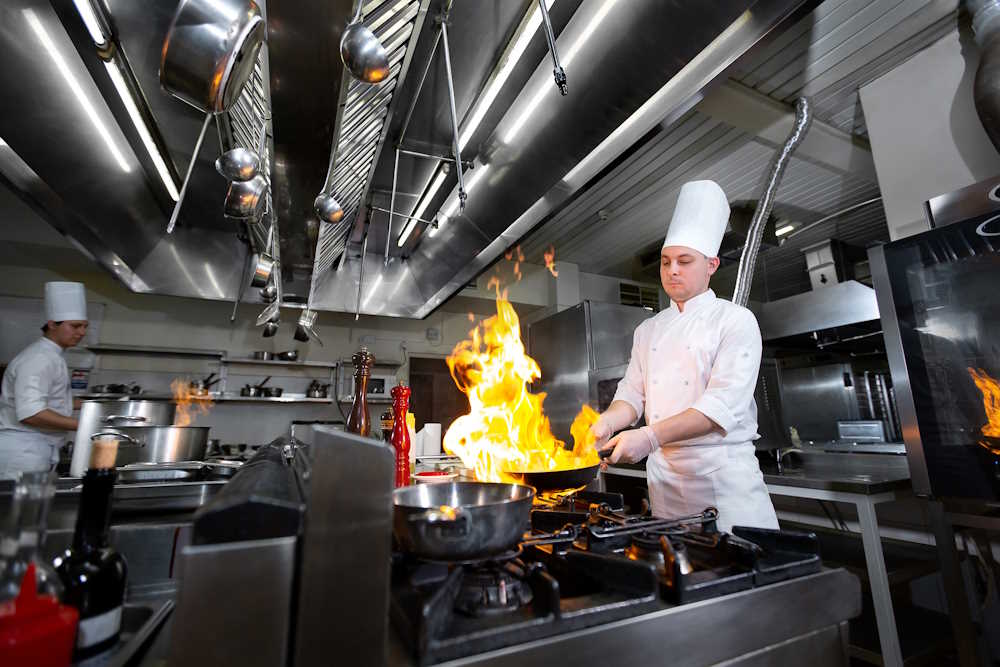Your commercial kitchen’s exhaust system is more than just a functional necessity – it’s the backbone of a safe, efficient, and compliant kitchen. Neglecting regular maintenance can lead to fire hazards, regulatory fines, poor air quality, and even operational shutdowns. A well-maintained system mitigates these risks and ensures seamless day-to-day operations and a safe environment for staff and patrons alike.
Understanding the Components of Your Exhaust System
Hoods and Canopies
Hoods and canopies are the first line of defence, capturing grease, smoke, and steam directly above cooking surfaces. Built from durable materials like stainless steel, these components are designed to handle the rigours of a commercial kitchen.
However, grease buildup is a persistent challenge. Over time, this accumulation can obstruct airflow, reduce efficiency, and significantly increase the risk of fire. Regular cleaning and inspection of commercial hoods and canopies is essential to maintain their effectiveness.
Also see: Signs That Your Commercial Kitchen Exhaust System, Canopy, and Duct Need Cleaning
Filters
Filters play a crucial role in trapping grease and preventing it from entering the ductwork. Different types of filters are available, each suited to specific needs:
- Baffle Filters: Durable and easy to clean, making them a popular choice for most kitchens.
- Mesh Filters: Lightweight but prone to clogging, requiring frequent maintenance.
- Honeycomb Filters: Highly efficient and ideal for heavy-duty applications.
To ensure optimal performance, filters must be cleaned regularly to prevent grease saturation, which can hinder airflow and compromise safety. In some cases, timely replacement is necessary to maintain system efficiency.
Ductwork
Ducts channel smoke, grease-laden vapours, and heat out of the kitchen. Properly designed and installed ductwork ensures efficient airflow and minimises risks. However, grease accumulation and airflow obstructions are common issues that can escalate into severe fire hazards if not addressed promptly.
Routine inspections and cleaning of kitchen ductwork are critical to keeping ducts clear and functioning effectively.
See also: How Frequently Do Kitchen Ducts Need to Be Cleaned
Exhaust Fans
Exhaust fans drive airflow and expel contaminants from the kitchen. Proper sizing and placement are essential for consistent performance. Warning signs like unusual noises, reduced airflow, or uneven operation indicate that maintenance is needed immediately. Regular servicing of exhaust fans helps sustain airflow efficiency, ensuring the entire exhaust system operates smoothly.
Tips to Keep Your Commercial Kitchen Exhaust System Running Smoothly
Tip 1: Schedule Regular Cleaning to Prevent Grease Buildup
Grease buildup is the leading cause of kitchen exhaust fires, making a well-structured commercial cleaning program essential for safety and compliance.
- High-volume kitchens, such as fast-food outlets or large restaurants, typically require monthly cleaning due to heavy grease output.
- For moderate-volume kitchens, including mid-sized restaurants or schools, bi-monthly or quarterly cleanings are usually sufficient.
- Small cafes or seasonal operations classified as low-volume kitchens can manage with semi-annual cleanings.
A thorough commercial cleaning program ensures adherence to regulatory guidelines, enhances safety, and simplifies inspection processes.
See also: Expert Tips to Prepare Your Commercial Kitchen for a Health Inspection
Tip 2: Follow a Step-by-Step Cleaning Process
A structured cleaning process ensures thorough maintenance and prevents damage to system components:
- Begin by turning off the power supply to ensure safety and cover all equipment and surfaces to avoid contamination.
- Carefully remove filters to prevent damage, clean them with appropriate solutions, and inspect them for wear.
- Replace filters as needed to maintain airflow efficiency.
- For ducts and hoods, use specialised tools to clean accessible areas thoroughly and ensure bare-metal cleaning without causing damage.
- For inaccessible areas, consider hiring professional cleaning services.
- When inspecting fans and motors, check for loose components, clean fan blades, lubricate moving parts, and tighten fasteners to optimise performance and prolong the system’s life.
Tip 3: Watch for Signs Your Exhaust System Needs Immediate Attention
Visible grease accumulation on walls, ducts, and hoods is a clear indicator that your system needs immediate attention. Regular inspections help detect commercial kitchen exhaust system issues before they escalate. Ignoring grease buildup increases fire risks and disrupts airflow.
Keep Your Commercial Kitchen Safe and Efficient with Expert Maintenance
Maintaining your commercial kitchen exhaust system is essential for safety, efficiency, and compliance. Regular cleaning, preventative measures, and professional services ensure optimal performance and reduce risks.
Protect your kitchen and enhance its operations with the help of Lotus Commercial. We are a trusted professional service with extensive experience delivering expert cleaning solutions. Our tailored maintenance plans address the unique demands of commercial kitchens, helping you stay compliant and operational.
Contact us today to discuss how we can keep your kitchen safe, compliant, and running smoothly.

